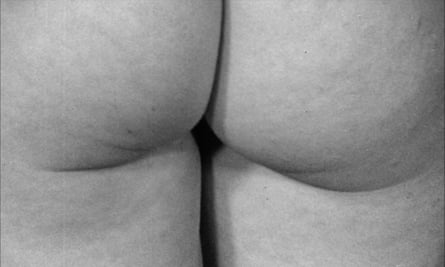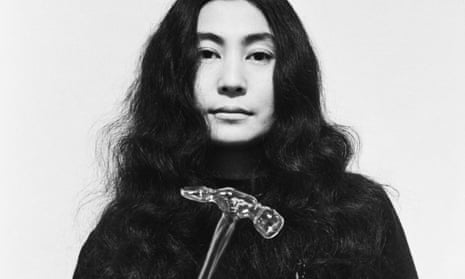It opens with a phone call. Eventually the artist picks up. “Hello! This is Yoko”, she says, then puts the phone down. It’s an old call, from the days before we had answering machines. The recording is also the last track on Ono’s 1971 album Fly, and it is the first thing you hear as you enter her Tate exhibition Music of the Mind. Music? Sometimes it is a bore, sometimes it is silent and sometimes a mindfuck. Use your imagination. But before we get to Ono’s repeated roars and screams and keening, fluttering cries, there’s the noise of a toilet flushing and a disembodied recording of Ono coughing, intermittently, for 30 minutes and 18 seconds. There goes that damn phone again, and this time the artist answers in Japanese. We’re still barely at the entrance, and I’m pondering a little stencilled statement, in the artist’s handwriting, stuck to the wall and telling me that the room moves at the same speed as the clouds. Good to know – but doesn’t it depend which way the wind is blowing in relation to the Earth’s rotation and its orbit of the sun? Is this an exam?

We can’t hang about here all day worrying because there’s a queue building up and a lot of interacting to be done in the rooms ahead: paintings to be stepped on, walls to be defaced, messages of one’s own to be written, ladders to be climbed. To say nothing of the fact that according to the artist’s instructions I have to find a broken sewing machine and an enormous glass tank to put it in, and somehow drag the tank to a town square and get people to throw stones at it on a snowy night. Don’t ask why.
I like the audacity of Ono’s Instructions for Paintings [1961-2], especially as she decided that they should remain in the hinterland between the idea and the act, conjured in the mind of the reader as a sort of interruption in the flow of the everyday. They could be as implausible and as arch and extreme as she liked. In many ways, I prefer these to her participatory works, which at one time I’d have happily joined in with. My days of rolling around the floor while hidden in a bag are over, sad to say.
You can shake hands with a stranger through a neat hole cut in a big blank freestanding canvas and in a piece called My Mommy Is Beautiful you’re invited to write something about your mother or stick a photograph of her to one of the 15 blank canvases hung in a row along one wall of the final gallery.
Now 90, Ono is still at it, though not making much art any more. And although many of Ono’s works were first originated as ideas and notes she wrote during the 1950s and 60s, I am sure her retrospective will be popular, not so much for students of fluxus and early performance and conceptual art, so much as for the opportunity to interact. Wanting to be more than mute spectators, audiences now want to do more than pay respect to history, to the blue chip and the elevated. They want to feel included and to have agency. From the start, this was something Ono acknowledged and encouraged.

Although much of Ono’s exhibition is taken up with parades of historical documentary photographs, with vitrines of flyers and invitations, tickets, programmes, announcements, posters, magazine spreads and other ephemera, there’s plenty else to snag the viewer. Ono draped over a grand piano, while John Cage and David Tudor tinker with the strings. Ono in downtown Manhattan, where she and composer, musician and performance artist La Monte Young initiated the Chambers Street loft concerts in 1961. Cage attended, Marcel Duchamp and even Max Ernst came.
Ono was famous before she was famous. She started out as a neo-dadaist and, like Cage, was an inspiration to the fluxus movement, or possibly anti-movement, initiated by George Maciunas, who took the idea of the Chambers Street loft and opened a gallery of his own. In a way, fluxus wanted to liberate art from itself. Fluxus, at least in Ono’s hands, was at once playful and poetic, and her exhibitions became participatory, theatrical events, the only script being Ono’s instructions, or objects and situations which we, the audience, have to improvise a response.
As well as early films of Ono smiling and blinking, and performing Cut Piece, here she is in bed with John Lennon, surrounded by newspapermen (they all seem to be men) and photographers, and conducting impromptu conversations with the hostile and bewildered journos. I much prefer Fly, a 1970-71 film she made with Lennon in which a woman lies on a bed while flies crawl over her naked body. A single fly is soon joined by others as Ono performs an astonishing range of vocalisations over scant instrumentation by Lennon. It is a haunting work.
When it hasn’t been derided, Ono’s voice has been compared to that of Meredith Monk and Diamanda Galás, and her vocalisations in the film Fly reminded me of listening to a Sámi performer imitating the infuriating noise of a mosquito and the cries of the wolf. Ono frequently takes her voice to its limits, something her art rarely has. Cut Piece, in which Ono sat on a stage next to a large pair of scissors, invited audience members to cut off her clothes. First performed in Tokyo in 1964, it predates Marina Abramović’s Rhythm O by a decade. While Abramović risked serious injury, rape and even murder, Ono’s Cut Piece was comparatively demure, but it is hard not to see it as a premonition of the vilification and the threats made to her after the Beatles split up.
With its messages of love and peace and togetherness, and its gentle forays into anti-art, Ono’s work has largely been only mildly confrontational, however much manufactured controversy it has elicited. Looking at her 1966-7 Bottoms film now, it is impossible to see what the fuss was about. There’s no flashing or dick-swinging, and the parade of bare buttocks feels innocent and chaste, however steamed-up Radio 4’s Today programme and the tabloids got about it at the time. The film was promptly banned by the British film censors. I stood there wondering which bottoms belonged to which famous artists.
after newsletter promotion

A lot of Ono’s later work is weak, never mind the symbolism or its staging as a platform for participation, or its essentialist pleas for us to imagine peace. In her 2001 Helmets (Pieces of Sky) a number of German second world war helmets are upturned and hung from the ceiling, like so many planters. Instead of geraniums they’re filled with blue jigsaw puzzle pieces which, if assembled, would create a sky. This is all a reference to Imagine. The song she wrote with John Lennon in 1971, for which she only received a writer’s credit in 2017.
Towards the end, a white boat sits in a room whose walls and floor are also completely white. Add Colour (Refugee Boat), first realised in 2016 – from an idea she had in 1960 – invites the audience to paint messages and symbols wherever they can reach, using the brushes and blue paint provided. Photos of the work installed in Portugal in 2020 document the boat adrift in a splurging sea of messages, of names and hopes and calls for freedom. I’m sure something similar will happen to this pristine boat in its white void at Tate Modern. Ono is the invisible helmswoman. You might say it is a bit hokey and obvious, but somehow it still touched me.
